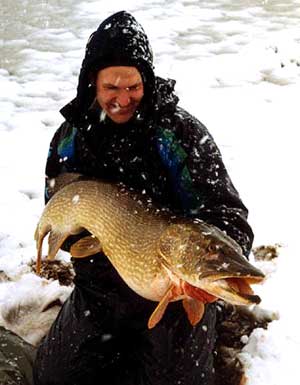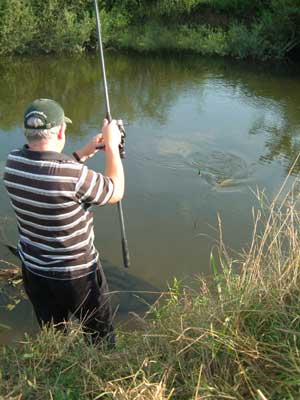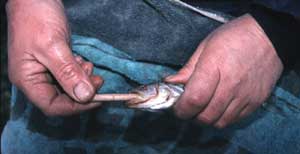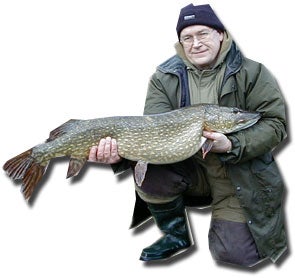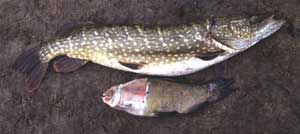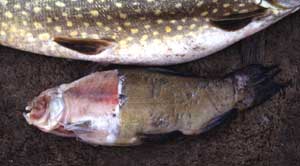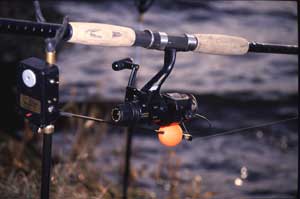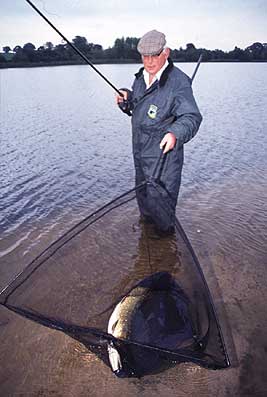I’m sure pike suffer from PMS (Predatory Mood Swings) for you just never know when you’ve got them taped. Now and again we think we know exactly how to fish a water for them, only to be brought straight back down to Earth on the very next visit. I’ve fished waters where, from years of experience, I’ve been convinced the best bait was a livebait, only to see my obligatory deadbait rod enjoy all the action. I’ve been sure on other waters that small baits were best only for the rod with the experimental big bait to have more takes than the rest put together. Other times I’ve caught all my fish from 60yds and more from the bank on waters where margin fishing has always been the best bet. There are countless other incidents I can recall that demonstrate that pike definitely suffer from PMS.
|
|
| |
Bait movement can be an essential ingredient
The only way to consistently beat them is never to take them for granted. Never assume that you know the best way of catching them, not even from your local water where you’ve fished all your life. Most of the time you’ll be right, of course, but there will be one day – probably more than one – where a complete change in bait or method, or both, will catch you fish that would have remained uncaught had you not removed the blinkers and allowed some fresh thinking to creep in.
Apart from lure fishing, any kind of bait movement can be an essential ingredient to pike fishing success, and there are many ways to impart movement to pike baits. These include the use of livebaits, twitching deadbaits, wobbling deadbaits, sink and draw, stretpegging, driftfloat fishing and trolling.
Rapid and exaggerated movement can often be the secret to attracting a pike’s attention when a stationary bait is being ignored. A combination of movement and fixed works too, as it did for me and Coarse Fisherman editor Stu Dexter a couple of weeks ago.
|
|
| |
Stu continually tempted a pike to follow his lure but it kept stopping short. Changing the lure and the retrieve rate didn’t alter anything either, the pike, a high single figure fish, just kept following it in but not making any attempt to snaffle it. Stu shouted me to come and have a look (he was quite amused and bemused by now). So I dropped my float-legered sardine in the side, at the spot where he was retrieving to, and on the very next cast the pike followed the lure in, sank away, and my float took off. Really, it happened just like that.
Subtle movement can have a positive effect too. Many times a bait that has laid on the bottom totally ignored is not being ignored at all, but being watched by a cunning pike that can’t make its mind up whether it wants it or not. The slightest twitch of that bait can be enough to convince the pike that it does want it after all. The movement may have been enough to startle the pike into grabbing the bait, or it may have been more a case of the pike deciding it may as well have the bait before it made any further attempt to ‘get away’. Regular pike anglers know full well how often a deadbait, that could have been lay there for several hours, is grabbed the moment you begin to reel it in for another cast. It happens often enough to make either retrieving the deadbait, or merely twitching it, a frequently tried ploy.
Popped up baits at various depths
One of my favourite techniques is to fish a popped up deadbait at various depths. There’s nothing fancy about the rig, just a simple running leger, the weight on a run-bead and a link-swivel with rubber bead buffer as a leger-stop. The wire trace is about 15ins long and clipped to the link swivel. A length of 15mm diameter balsa wood is inserted into the fish, the bait cast out, the rod set in rests, and the bait pulled down to the leger stop and clipped up just tight enough to prevent the line from popping out. The clip on a drop-back bite alarm is perfect. When the top treble is nicked into the wrist of the tail of the bait it means the bait is standing on its tail with its head about 15ins from the bottom. This is fished as so for maybe 30 minutes and then the line is unclipped and the bait allowed to rise up another 6ins or so, and the line clipped up again. Every 10 or 15 minutes (or whatever length of time you think is right, or want to try) you repeat the process, 6ins at a time, until you reach the surface. Then let it lay there for a while until you retrieve the bait to begin the whole process all over again.
|
|
| |
Vary the technique
There are many variations to the technique. The obvious ones being the amount you allow the bait to rise each time you unclip the line, and how often you perform the ritual. Others include overloading the bait with buoyant material and allowing the bait to shoot to the surface. One of my favourites, when there are pike striking close to, or at, the surface, is to cast where I’ve seen the movement, tighten right up to the lead (which should be quite heavy, 2oz at least) and then let the bait shoot to the surface. Allow it to lie there for just a few seconds and then slowly draw the bait back down to the bottom. You draw the bait to the bottom by grasping and pulling, hand over hand, a loop of line between butt ring and second ring. That way you can feel immediately you get a take and can then let go of the line to allow the pike some free line to get the bait well into its mouth. A few seconds, or a minute or two later, you let the bait shoot to the surface again. And so on. Another thing I do is inject the bait with plenty of bait flavour, the fish-oil ones manufactured for pike fishing being ideal. I overload them with oil with the express purpose of leaving a trail of flavour from bottom to surface. If you don’t get any takes in a reasonable time it is easy to clip up the bait to fish at whatever depth you fancy while you take a break.
|
|
| |
A right greedy git!
It was while myself, Dave Colclough, and John Charlesworth were fishing like so on a Cheshire mere two or three winters ago when something very unusual happened. It’s a good example of pike PMS at work. But let me tell you something about the mere first.
Most Cheshire meres are not renowned for producing big pike, but they are nice waters to visit for a few hours enjoyable fishing when there is no time to go farther afield for bigger fish. One mere in particular has, in the past, regularly produced half a dozen or more pike to mid-doubles (if you were lucky) in a day, but up to half a dozen jacks was more likely. There were very few small prey fish in the mere (the water being renowned for its big tench) and as a result the pike were always hungry. You could catch them on practically anything, ranging from small livebaits to full mackerel deadbaits. And they weren’t bothered about how they were presented; popped up or hard on the bottom, or hanging from a float. More often than not they took them as they came, no questions asked.
Then, about four years ago, the mere changed, in that a shoal of roach appeared from practically nowhere. A shoal that grew a lot in numbers and a little in size almost every time we saw them. Not surprisingly we also saw that the pike were getting fatter and were becoming harder to catch. Gone were the long, skinny bodies, and pike in double figures were being caught more often. They didn’t want our baits so badly as they did before and we had to work harder to catch fewer fish. Roach livebaits weighing 3oz to 6oz were the best baits, fished either under a float a foot or so off bottom, or legered on the bottom. Popped up roach deadbaits were good too, outfishing any other deadbait.
|
|
| |
|
|
| |
So, on a dour day when nothing moved, including me, Dave Colclough and John Charlesworth (apart from the times we unclipped and allowed the baits to rise to, or drew them back from, the surface) we fished the mere for pike. We each fished live and dead roach baits on two rods each, and each had a token rod out legering a bigger sea species deadbait. We huddled under the brollies for six hours or more with not an indicator dropping off, nor a float slipping away, due to pike interference, to break the monotony. Then there was a click as line was pulled from a clip, and the alarm on John’s drop-off indicator cried out for attention. It was the rod that was fishing a big half mackerel. It didn’t take long to land a fat pike that weighed 12lb 8oz. As the fish lay in the folds of the weigh-sling there was a loud belch and a black tail oozed out of the pike’s mouth, followed by a yellow, then pink, body of a part-digested tench. Out of curiosity we weighed the tench at 2lb 8oz, which meant it must have been a 3-pounder before being scoffed and part consumed by the pike.
|
|
| |
So here was a 10lb pike, well-fed on roach, that had taken a 3lb tench whose tail was still jammed in its throat – and then scooped up a big half mackerel! Talk about greedy, it was almost unbelievable.
Wonderful whiting?
On another mere a few weeks later another incident happened to demonstrate just what funny buggers pike can be. Dave and I fished a good mix of baits ranging from small livebaits to large(ish) deadbaits, using both leger and float methods. The only bait I wasn’t using, amongst those I had with me, was a whiting. I had just the one in the freezer box, which I thought was probably one too many. Whiting, I’ve found, depending on the water, can either be absolutely superb pike baits. or absolutely crap. There doesn’t seem to be any in-between with them. I’d tried them several times on this mere over the past three or four years and never once had a take. That day we couldn’t get a take on anything, so with not much more than an hour to go before we had to pack for home I slipped a full half pound whiting onto my trebles, slipped a length of balsa down its throat, and cast it about 30yds out.
|
|
| |
In less than five minutes it was away, resulting in a pike of 11 or 12lb. The whiting was shredded but still okay to use. Again, it couldn’t have been more than five minutes before the line pulled out of the clip and the arm from the alarm fell down. Another low double. This time the whiting was mauled quite badly, the head end hanging in shreds. I whipped some fine elastic round the trebles and the fish to hold them in place and cast out again. But not casting as far because I was wary of throwing the bait – or a good portion of it – off the hooks. It didn’t make any difference, for it took off on another run in less than ten minutes. This time a jack of about 6lb. In that ten minutes both Dave and I had reeled in another rod each and cast the baits very close to the areas where I had the takes on whiting.
Those rods lay quiet as the grave as the whiting rod continued to catch. A total of seven pike grabbed the whiting before I finally lost the remaining sliver the last fish had taken. Other baits were cast into the area but not a thing came of it. The only other time I’ve witnessed anything like it was when Tony Kelly used whiting on Lough Gara in Ireland. Tony had only the one bait with him, but caught several pike on it before he lost it forever when he threw it off the hooks. To make it even more of a mystery we’ve fished the mere three times since and caught on everything we’ve offered the pike – except whiting! And Lough Gara’s pike have also not shown any interest in whiting since that day when Tony had them craving for it.
If there is one thing I’ve learned above all else with all fish, but especially with pike, it is not to take anything for granted and very regularly fish a rod that goes against the grain. Which means that I shall carry on trying whiting on one rod no matter how many times I visit waters where they are usually ignored. I shall keep imparting movement to pike baits rather than just sit there waiting for something to happen. And I shall never, ever, take them for granted.










